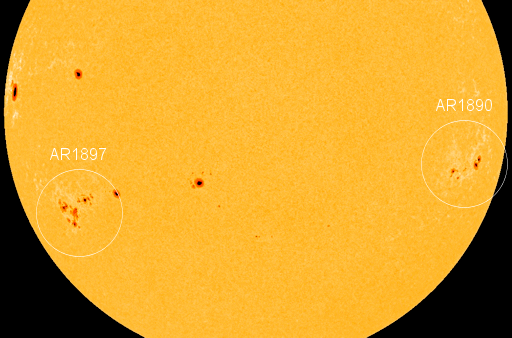WHAT WENT WRONG ON MARS? Mars was once on track to become a thriving Earth-like planet, yet today it is an apparently lifeless wasteland. A NASA spacecraft named MAVEN will soon journey to Mars to find out what went wrong on the Red Planet. Get the full story and a video from Science@NASA.
WAITING FOR THE NEXT FLARE: Solar activity has been low for 24+ hours, but the forecast calls for flares. Two large, complex sunspots are transiting the Earthside of the sun with mixed-polarity magnetic fields that harbor energy for strong eruptions. The next big flare will probably come from one of these two circled regions:
NOAA forecasters estimate a 60% chance of M-class flares and a 30% chance of X-flares during the next 24 hours. Flares from AR1890 could be particularly geoeffective. Because of the way the sun's magnetic field spirals through interplanetary space, AR1890 is magnetically connected to our planet. Particles accelerated by an explosion there would be guided in our direction, possibly causing a radiation storm around Earth. Stay tuned. Solar flare alerts: text, voice

Solar wind
speed: 375.5 km/sec
density: 1.4 protons/cm3
explanation | more data
Updated: Today at 1616 UT
X-ray Solar Flares
6-hr max: M1 1520 UT Nov13
24-hr: M1 1520 UT Nov13
explanation | more data
Updated: Today at: 1600 UT
![]()
Daily Sun: 13 Nov 13
Sunspot AR1890 has a 'beta-gamma-delta' magnetic field that harbors energy for X-class solar flares. Sunspot AR1897 has a 'beta-gamma' magnetic field capable of producing M-class flares. Credit: SDO/HMI
![]()
Sunspot number: 147
What is the sunspot number?
Updated 13 Nov 2013
Spotless Days
Current Stretch: 0 days
2013 total: 0 days (0%)
2012 total: 0 days (0%)
2011 total: 2 days (<1%)
2010 total: 51 days (14%)
2009 total: 260 days (71%)
Since 2004: 821 days
Typical Solar Min: 486 days
Update 13 Nov 2013
The Radio Sun
10.7 cm flux: 168 sfu
explanation | more data
Updated 13 Nov 2013
![]()
Current Auroral Oval:
Switch to: Europe, USA, New Zealand, Antarctica
Credit: NOAA/POES
![]()
Planetary K-index
Now: Kp= 2 quiet
24-hr max: Kp= 2 quiet
explanation | more data
Interplanetary Mag. Field
Btotal: 3.4 nT
Bz: 1.9 nT south
explanation | more data
Updated: Today at 1616 UT
![]()
Coronal Holes: 13 Nov 13
Solar wind flowing from the indicated coronal hole could reach Earth on Nov. 16-17. Credit: SDO/AIA.





